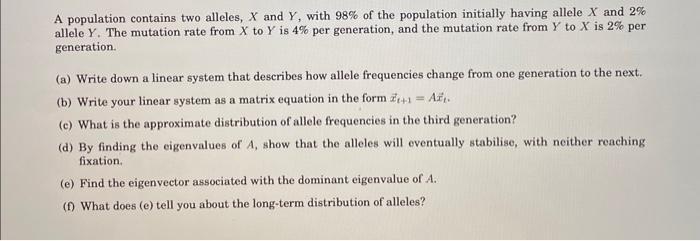Answered step by step
Verified Expert Solution
Question
1 Approved Answer
A population contains two alleles, X and Y, with 98% of the population initially having allele X and 2% allele Y. The mutation rate

A population contains two alleles, X and Y, with 98% of the population initially having allele X and 2% allele Y. The mutation rate from X to Y is 4% per generation, and the mutation rate from Y to X is 2% per generation. (a) Write down a linear system that describes how allele frequencies change from one generation to the next. (b) Write your linear system as a matrix equation in the form +1 = A. (c) What is the approximate distribution of allele frequencies in the third generation? (d) By finding the eigenvalues of A, show that the alleles will eventually stabilise, with neither reaching fixation. (e) Find the eigenvector associated with the dominant eigenvalue of A. (f) What does (e) tell you about the long-term distribution of alleles?
Step by Step Solution
There are 3 Steps involved in it
Step: 1
a To describe how allele frequencies change from one generation to the next we can set up a linear system of equations Lets denote the frequency of allele X in generation n as Xn and the frequency of ...
Get Instant Access to Expert-Tailored Solutions
See step-by-step solutions with expert insights and AI powered tools for academic success
Step: 2

Step: 3

Ace Your Homework with AI
Get the answers you need in no time with our AI-driven, step-by-step assistance
Get Started


